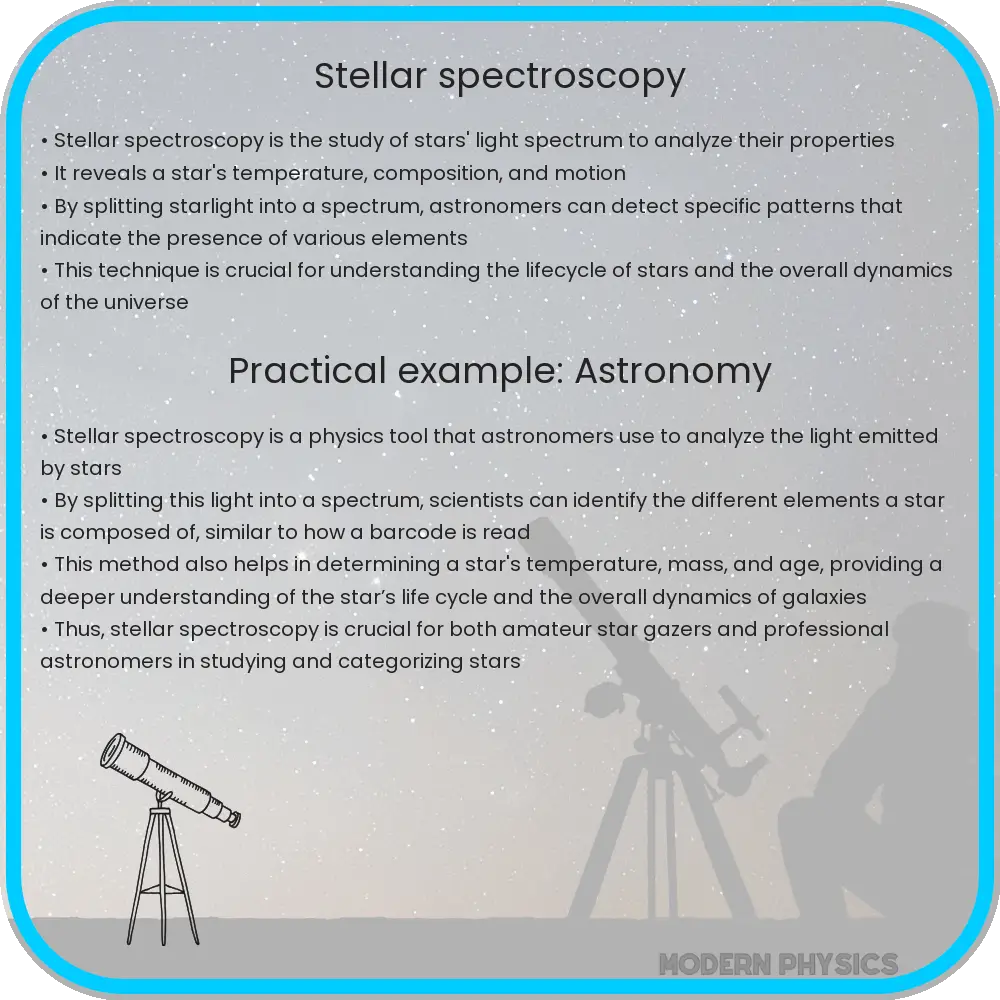Explore stellar spectroscopy: the technique unlocking the secrets of star composition, spectra types, and celestial dynamics to advance our cosmic understanding.

Introduction to Stellar Spectroscopy
Stellar spectroscopy is the science of analyzing the light emitted by stars to understand their various properties and compositions. By splitting starlight into its component colors or wavelengths, astronomers can decipher a wealth of information from the spectral lines that appear. This method has been fundamental in classifying stars, understanding stellar life cycles, and mapping the chemical abundance of the universe.
Understanding Stellar Light
Stars emit light due to the thermonuclear reactions occurring in their cores. This light, when analyzed, carries the fingerprints of the elements present within the star. Each chemical element absorbs light at specific wavelengths, leading to dark absorption lines in the star’s spectrum, which are as unique as fingerprints. By comparing these lines to known standards, astronomers can identify the elements and their abundances in the star’s atmosphere.
Types of Stellar Spectra
Stellar spectra can be broadly categorized into three types based on the absorption lines present: O, B, A, F, G, K, and M, a sequence that reflects the surface temperature of the stars from hottest to coolest. This classification is further refined by adding numerical subdivisions and luminosity classes, giving a more detailed understanding of a star’s physical properties.
Spectroscopic Analysis and Star Composition
The detailed analysis of stellar spectra allows scientists to determine not only the star’s chemical composition but also its temperature, gravity, and magnetic field. For instance, helium lines dominate the spectra of extremely hot O and B type stars, while cooler K and M types show strong molecular bands due to compounds like TiO. Furthermore, the presence of certain elements like lithium can provide clues about a star’s age and evolutionary state.
Chemical Footprints in Stellar Spectra
The unique patterns observed in stellar spectra are due to the energy levels of electrons in atoms. When an electron transitions between energy levels, it absorbs or emits light at specific wavelengths, leading to the characteristic absorption and emission lines. For example, the hydrogen Balmer series, visible in many stellar spectra, appears due to transitions in the hydrogen atom’s electron configurations. The strength and width of these lines can reveal not only the hydrogen content but also surface gravity and pressure conditions.
Applications of Stellar Spectroscopy
Stellar spectroscopy has vast applications in astrophysics. It is crucial for determining the distances of stars through the luminosity-classification system. The Doppler effect, observed in the shift of spectral lines, allows astronomers to calculate the velocity of stars moving towards or away from us, providing vital data on star and galaxy dynamics. Additionally, spectroscopy aids in the discovery and characterization of exoplanets through transit spectroscopy, where the composition of an exoplanet’s atmosphere is deduced by analyzing the spectrum of the starlight passing through it.
Advancements in Spectroscopic Techniques
Technological advancements have dramatically enhanced the capabilities of stellar spectroscopy. Modern instruments, such as the Hubble Space Telescope and ground-based telescopes equipped with high-resolution spectrometers, allow for more detailed and distant cosmic studies. Techniques like high-dispersion spectroscopy and echelle spectroscopy offer greater detail and precision, enabling the detection of finer spectral lines and, hence, more accurate chemical compositions and physical properties of celestial objects.
Challenges and Future Directions
Despite its successes, stellar spectroscopy faces challenges such as atmospheric interference, light pollution, and the need for extremely high-resolution data to analyze distant or faint stars. Future advancements are likely to focus on space-based spectroscopy to bypass atmospheric distortions and on the development of more sensitive detectors and advanced algorithms for data analysis. These improvements will enable deeper insights into the universe’s structure, the life cycle of stars, and the distribution of elements across galaxies.
Conclusion
Stellar spectroscopy is a fundamental tool in the astrophysicist’s arsenal, offering a window into the composition and dynamics of the cosmos. By analyzing the light from stars, scientists can unlock secrets from chemical compositions to the laws governing the universe’s evolution. As technology advances, so too will our understanding of the stars and galaxies that populate the night sky, continuing the age-old human quest to understand our place in the universe.
